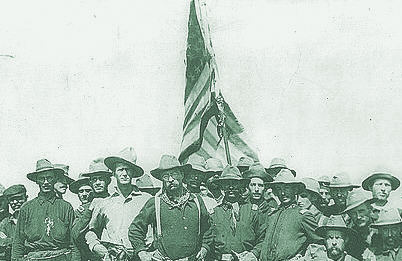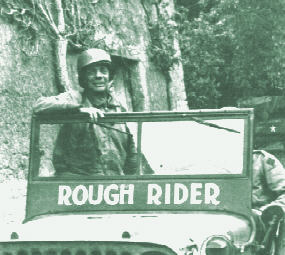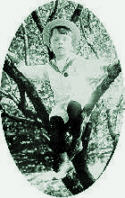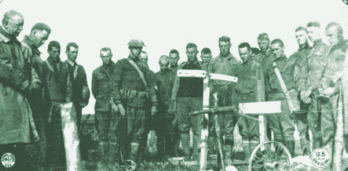Excerpted from:
The Lion's Pride: Theodore Roosevelt and His Family in War and Peace
Reprinted by permission of the Author and Publisher
THEODORE ROOSEVELT'S FAMILY IN THE GREAT WAR
by
EDWARD J. RENEHAN, JR. |

The Patriarch Atop San Juan Ridge with the Rough Riders
How the Roosevelt Children Caught the Martial Spirit
Teddy Roosevelt's children grew up in the glow of Roosevelt's crowded hour. (In his father's office at the White House, 10-year-old Quentin Roosevelt brandished his father's sword from the Cuban campaign, shouting "Step up and see the i-d-e-n-t-i-c-a-l sword carried by Colonel Thee-a-dore Roos-evelt in the capture of San Juan Hill. See it! See it!" Swinging the sword through the air, the boy opened a cut on the cheek of his friend Charlie Taft, son of Theodore Roosevelt's Secretary of War William Howard Taft.) All of the boys in their time tromped the grounds of Sagamore Hill and the White House, re enacting the battle at San Juan Ridge.
All the Roosevelt children -- most especially the sons -- either absorbed or inherited his reckless, all-or-nothing approach to hazards. As David McCullough reminds us with reference to the Roosevelts, the pediatric psychologist Margaret McPharland says attitudes are caught more than they are taught. With this in mind, we may say Theodore Roosevelt's sons most certainly caught both his attraction to warfare and his egalitarian ethic.
Throughout World War I, Ted Jr. would be alternately praised and criticized as an officer who routinely and boldly moved ahead of the line in battle after battle. In each of the world wars, he was at once idolized by his men, with whom he shared all dangers, and criticized by career officers, who respected Ted's bravery more than they did his judgment. The same officers also sometimes found themselves reprimanding him for insubordination, reminiscent of his father's in '98. Patton, who admired Ted Jr. in many ways, wrote of him: "Great courage, but no soldier."
Archie was the same way. So were Kermit and Quentin. One contemporary from the Great War called Arch "an absolutely selfless gladiator who insisted on being the first to smell the enemy's bad breath, regardless of the risk." Arch earned a similar reputation yet again in the South Pacific during World War II. During World War I Kermit was lightly reprimanded while fighting with the British in the Middle East. Some victories, said Kermit's British colonel, could very well be hand without full frontal assaults into the gaping mouths of enemy guns...
As for Quentin, his friend Hamilton Coolidge wrote that "his daring was difficult to understand." He was possessed by an "utter fearlessness" that "perhaps caused his death." Just three days before Quentin's death in 1918, the New York Sun congratulated him editorially for "attacking three enemy airplanes single-handed and shooting one of them down." In so doing, said the newspaper, Quentin was "running true to Roosevelt form." The editorial concluded by noting "each of the vigorous Colonel's four sons is out to make a record worthy of their father..."
[Ethel had also] been a notoriously pugnacious child. Stocky, muscular, and athletic [Roosevelt] told a friend she was "a jolly naughty whacky baby too attractive for anything, and thoroughly able to hold her own in the world."

Roosevelt Family
First World War Service
|
Name
|
Relationship
to
T.R.
|
Role and Unit
|
Comments
|
| Archie R. |
Son |
Officer 16th, 26th US Infantry |
Severely wounded March 1918; awarded Croix de Guerre. Served again with distinction in WWII. |
| Dick Derby, MD |
Son-in-Law, Ethel's Husband |
Surgeon with Ambulance Americaine and, later, US Medical Corps |
Caught pneumonia treating doughboys in 1918. |
| Ethel R. Derby |
Daughter |
Nurse at Ambulance Americane |
Returned home mid-war to help family. |
| Eleanor Alexander R. |
Daughter-in-Law, Ted's Wife |
Volunteer, YMCA |
Served in Paris |
| Kermit R. |
Son |
Officer, British Expeditionary Force, Mesopotamia; U.S Field Artillery |
Awarded British Military Cross and served with distinction with AEF in Meuse-Argonne Offensive. Served again in WWII. |
| Quentin R. |
Son |
Pilot, 95th Aero Squadron |
Killed in action, 14 July 1918; reburied next to brother Ted at the US Cemetery and Memorial, Normandy. |
| Ted R., Jr. |
Son |
Officer 26th US Infantry |
Gassed at Cantigny; wounded on 19 July 1918; later awarded Medal of Honor as WWII general; buried next to Brother Quentin at Normandy. |

Ted during World War II
Learning of the Death of a Son

Quentin |
Very early the next morning, the 17th [of July, correspondent Phil Thompson] knocked at the door of Sagamore Hill. He carried a dispatch, unofficial, announcing Quentin had been shot down over enemy lines. There was no further information. It was not to be known for three more days whether Quentin was alive or dead, although Roosevelt seems to have instantly assumed the worst.
The colonel held the dispatch in his hand, walking back and forth across the length of the piazza in the early morning sunshine. "But Mrs. Roosevelt!" he told Thompson, "How am I going to break it to her?" After more pacing, Roosevelt went into the house, from which he did not emerge for thirty minutes. When he came out, he held in his hand a brief statement. "Quentin's mother and I are very glad that he got to the front and had a chance to render some service to his country, and show the stuff that was in him before his fate befell him."
Roosevelt spent the remainder of the day indoors, tending to business. He dictated the mail to [Secretary Josephine] Stricker, who remembered "his voice choking with emotion...and the tears streaming down his face." Later in the day, while Roosevelt exorcised his grief by waging war on his mail, Edith came to speak to Thompson, who was keeping a vigil outside the house. Her eyes were red, but she bore herself with dignity. "We must do everything we can to help him," she said, referring to Roosevelt. "The burden must not rest entirely on his shoulders."
On the follow morning, she accompanied Roosevelt to the Republican State Convention at Saratoga, New York. . . Isaac Hunt, a friend who was in the audience for Roosevelt's Saratoga speech , told Herman Hagedorn later he had never seen a face marked by such extreme human misery as was Roosevelt's when he mounted the convention dais. The audience to whom Roosevelt spoke did not yet know about Quentin; and he would not be the one to tell them. Nevertheless, Quentin was present in the speech.
"The finest, the bravest, the best of our young men have sprung eagerly forward to face death for the sake of a high ideal. . ." he said. " When these gallant boys, on the golden crest of life, gladly face death. . . shall we who stay behind, who have not been found worthy of the great adventure. . . try to shape our lives so as to make this country a better place to live in. . . for the women who sent these men to battle and for the children who are to come after them?"

Ceremony at Quentin's Original Burial Site, Chamery, France
. . . In the succeeding weeks, Roosevelt started to vaguely resemble himself again, even though he would never again be as he had been before the loss of Quentin. Despite his affable good humor and energetic need to continue to contribute to public life, his old exuberance had left him, never to return. No one was more attuned to this fact than Edith. "Quentin's death shook him greatly," she wrote Kermit. "I can see how constantly he thinks of him and not the merry happy silly recollections which I have but sad thoughts of what Quentin would have counted for in the future."
Editor's Note. After his son's death, Theodore Roosevelt's health declined rapidly. He died within six months on January 6, 1919. Quentin was one of over 116,000 American service men, mostly young like himself, to die in the Great War.
|





